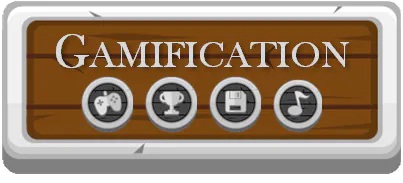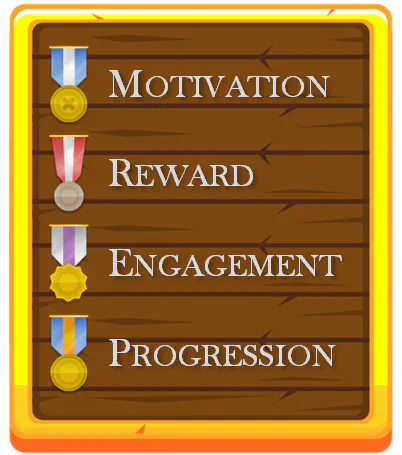
Gamification as a form of Motivation
- Glenn Prince
- University
- July 17, 2018
Table of Contents
As part of, what turned out to be, a far ranging discussion with Sally Brandon, my tutor related to the Gamified Media unit I am taking this trimester, we explored some interesting topics around motivation, task management and work management practices. I found the conversation around both my own personal task management practices, as well as typical development and project management practices around managing work, really got me thinking about motivation and gamification of tasks. In particular I thought I would take a bit of a dive into the types, benefits and disadvantages of progression and reward systems that organisation and gamification applications apply to motivate and gamify tasks.

Motivation
It’s important, I think, to quickly touch on first the two types of motives or drivers for action - internal / intrinsic and external / extrinsic. This definition from a psychology course on study.com (Boyd, 2018) is a pretty good summary:
- Intrinsic motivation is when you do something because you enjoy it or find it interesting.
- Extrinsic motivation is doing something for external rewards or to avoid negative consequences.
Obviously, its a lot easier to do anything where you have a high intrinsic motivation, and in some cases a high extrinsic motivation, but gamification really looks at how to can add extrinsic motivation when you have a low, or a lapse in, motivation.
Reward
As part of our discussion, we talked quite a bit about reward and reward systems, mainly related around applications Sally and myself have used for keeping track of tasks and staying motivated, including:
- Habitca - A gamified task management mobile application you use to manage tasks and form habits
- Forest - A gamified focus mobile application you use to stay on task
- Trello - A free kanban board style application I use as a personal organiser in a Scrum style way
- Basecamp - A project management and team communication application used by project teams in a number of enterprises
All of these applications have reward elements in them, the gamified applications have game style rewards for checking off tasks or maintaining focus, the more traditional applications have the reward of moving the cards to the done pile or having your finished task displayed publicly. It’s these external reward systems that trigger our internal reward system - particularly dopamine (Banks, 2015) - that drive us to repeat the process.
Engagement
The discussion on reward systems led into some of the reasons why I myself have found some of the more gamified applications don’t particularly suit me, and part of that is engagement. If we, for instance, take Habitca as an example and why I didn’t feel any great desire to use it, even though I enjoy and play a lot of role-playing games, it can be boiled down to a key factor, engagement. Part of this lack of engagement may be that I’m already using a task tracking system that works for me, but I think also that part of it is completing tasks within the application just doesn’t seem engaging.
https://www.glennprince.com/gamification-as-a-form-of-motivation-02.png does not existAs petty as it sounds, there is something focusing about moving a task from my backlog queue to my doing queue, and there is something satisfying about picking up that card in the doing pile and moving it onto the done pile. In contrast, ticking one check box in a potentially huge list of checkboxes seems anti-climactic. I just spent 30 mins, 60 mins, most of the morning doing this task and then, tick. The it’s looking through my list and wondering what to do now, guess I’ll try this, without actually ever doing anything …. how do I know which task I’m on track for?
Most of this is what the Grapefrukt game developers like to call “Juiciness”, “amping up” the application with engaging visual and interactive feedback. For instance, it would be nice to some of the following to make it a bit more engaging:
- Assigning tasks to a current quest list or getting tasks off a quest master
- Make finishing a task a bit more interactive, moving them off a list, handing them into the quest master etc.
Progression
The one thing that all of these applications do is show your progression, giving you feedback about your progress and how far you have come. Seeing your progress is an important feedback loop, once you have completed tasks. For gamification applications this progression is normally represented by character increases, collecting gold and items, or building your base. For non-gamified applications, at least for me, this is the pile completed tasks. Having a visual representation of the path you came from can be another really good motivator.
What about you ?
Have you used any other task management or gamified applications that help you manage your tasks and workload? Leave a comment below, especially if you made the transition from a Kanban board to a gamified task management application.
Reference
Boyd, N. (2018). Intrinsic and Extrinsic Motivation in Education: Definition & Examples. Available at: https://study.com/academy/lesson/intrinsic-and-extrinsic-motivation-in-education-definition-examples.html [Accessed 18 Jul. 2018].
Banks, A (2015). The Dopamine Reward System: Friend or Foe. Available at: https://www.psychologytoday.com/au/blog/wired-love/201507/the-dopamine-reward-system-friend-or-foe [Accessed 18 Jul. 2018].